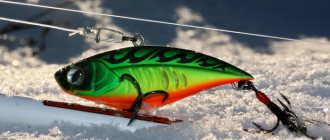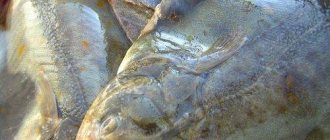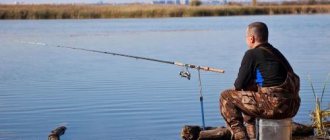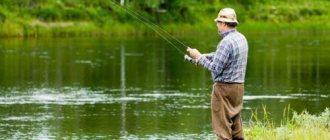Perch-aukha, or Chinese perch, or bluefin is found in the Russian Federation only in the river basin. Amur. A fish of bright exotic appearance from the order Perciformes (Bleeker, 1859), the family Percichthyidae (Jordan et Eigenmann, 1890) and the genus Siniperca (Gill, 1862).
Sometimes it is called a ruff for its strong and sharp spines in its fins. Although G.V. Nikolsky (1956) pointed out that calling an aukha a ruff is incorrect. The Nanai people call perch aukha, audze; Chinese - sai-hua-yu, ao-hua-yu, kuei-yu; Japanese - kaurai ketzu chio, ketzu chio. The correct name is perch-aukha.
The Chinese perch, as well as the Amur killer whale, the sloth gudgeon, and the Chersky sloth gudgeon are of such an unusual color that they cannot be confused with any other Amur fish. And if you remember about catfish and Amur pike, then you can forget about perch.
What does the perch look like (Siniperca chuatsi (Basilewsky, 1855))
The body is tall, laterally compressed; thick and wide, one might say spade-shaped; covered with small scales. The color is variegated. It retains the brightness of its outfit only in water. In air the color fades and turns gray. The back is gray or greenish-gray. The sides are silvery-yellowish with irregular, sometimes vague dark spots.
The unpaired fins have bright black spots. The dorsal fin is single and has a notch between the spiny and soft rays. Paired fins are light. The caudal fin is rounded. Pelvic fins with powerful spines. The mouth is big. The lower jaw protrudes forward. The gill covers are covered with scales and have spines along the edges. The iris is silvery, sometimes slightly yellowish.
There are practically no differences between males and females. Only females are larger than males. With age, the fish becomes wider and the tail becomes shorter. Be that as it may, the aukha perch is similar to the common perch. Although, unlike it, aukha is a large fish. The weight reaches 7–8 kg, and the length of the auha perch grows up to 70 cm. By the way, the largest aukha that was caught in the Amur weighed 8.6 kg.
Recently, the genus Siniperca and the genus Coreoperca have been identified by a number of experts as a separate family, Chinese percides (Sinipercidae (Katayama, 1959)) (Nelson et al., 2016). However, the old taxonomic division is still preserved in the main ichthyological databases (Eschmeyer et al., 2016; Froese, Pauly, 2017).
Description
Many people know perch, but not many have heard of its Chinese relative.
Perch-auha, Chinese perch - that’s what they call it. A freshwater predator, quite large in size, grows up to 9 kg and can be up to 70 cm long. Lives no more than 10 years. Aukha has a rather tall, humpbacked body, flattened laterally. The fin is double, the back part is longer and not as spiny as the front. The lower jaw protrudes beyond the upper jaw. The large head and large toothed mouth indicate a voracious predator.
This perch is very beautiful, with dark, leopard-print spots, marsh, light brown or gray scales, and bright, orange-yellow-black fins. It’s not for nothing that in China they call it “mandarin duck”.
Spreading
Endemic to East Asia. Found from the Amur and northwestern Sakhalin to Xijiang. In the Khabarovsk Territory it lives in all municipal areas along the Amur and Ussuri. In summer it can reach the river. Amgun (P. Osipenko area) and the lower reaches of the Kur and Urmi rivers. In the Primorsky Territory it lives in the river basin. Ussuri and lake Hanka. Found in the Jewish Autonomous and Amur regions. In “warm” low-water years, there is a possibility of habitat in the Chita region. It is also found in Sakhalin rivers flowing into the Amur Estuary. Outside Russia, it lives in China and Northern Vietnam.
In the vicinity of Khabarovsk, aukha is common and not uncommon in fishermen’s net catches and live bait catches. In recent years, fishermen have begun to successfully use various modern imported baits. The old “Soviet” spinner was not attractive.
G. V. Novomodny, 2014
Answers to the scanword of the day from Odnoklassniki number 22311
22310 22312
- in the photo there are 6 letters: CROUPIE
- Amur perch from 4 letters: AUHA
- in the photo from 7 letters: BALATON
- 5 letter artery: VESSEL
- Human nature from 6 letters: NATURA
- 4 letter fortune telling cards: TAROT
- Altaian (obsolete) from 5 letters: OIROT
- A patient's 5-letter trembling: CHILLS
- Computer company with 5 letters: INTEL
- Buryat dance of 4 letters: EXOR
- American economist with 4 letters: KNIGHT
- As, doka (jarg.) from 5 letters: PROFI
- Ostap’s “half-inventor” of 4 letters: ILF
- Center of Bashkiria from 3 letters: UFA
- One hundred Iranian dinars with 4 letters: RIAL
- It can be tolerated from 6 letters: FIASCO
- Daughter of Tantalus from 5 letters: NIOBE
- in the photo from 5 letters: SANIN
- Fashion designer Gasse from 4 letters: AINA
- Estonian writer with 5 letters: TRAAT
- People in Africa with 4 letters: ALUR
- Cooked a porridge from an ax with 6 letters: SOLDIER
- Container choice. 4 letter ballots: URNA
- Drying sea from 4 letters: ARAL
- American tank with 6 letters: ABRAMS
- Ivorian footballer with 6 letters: TRAORE
- Mikhalkov’s cinema “... love” from 4 letters: SLAVE
- Birch bark vessel with 5 letters: BURAK
- English snooker player with 5 letters: TRUMP
- Russian. revolutionary cruiser with 6 letters: AURORA
- in the photo there are 5 letters: LLOYD
- River in the Arkhangelsk region from 3 letters: OMA
- Light horse-drawn carriage with 5 letters: FIAKR
- Personification of rumor with 4 letters: FAMA
- Ilyushin city of 5 letters: MUROM
comments, questions and answers to the crossword puzzle of the day:
CROUPIE m. neskl. Banker and game manager in a gambling house.
VESSEL [1] m. 1. A container for liquid and granular bodies (jug, bottle, etc.).
VESSEL [2] m. 1. A tubular, elastic organ in the body of a person or animal through which blood or lymph moves. 2. An element of plant tissue in the form of a tube that serves to move water and substances dissolved in it.
NATURA w. 1. Innate temperament, human character. 2. Property, essence of something. 3. Goods, products as a means of payment instead of money. 4. Phenomena and objects of the real world, which are depicted by the artist directly observing them. 5. Location of filming in a natural environment (rural and urban landscape, etc.). // outdated Nature.
OIROT m. see Oirot.
CHILLS m. A feeling of cold that causes trembling in the body (with fever, nervous excitement, etc.).
PROFI pl. several decomposition Professional athlete.
RIAL m. 1. Monetary unit of Iran, equal to 100 dinars. 2. Coin of the appropriate denomination.
FIASCO avg. several Failure, failure, failure.
SOLDIER m. 1. Ordinary soldier of the ground forces. // Any military personnel. 2. transfer A devoted, persistent participant in something. social movement, member of smb. organizations, etc.
URN w. 1. A vessel - usually in the form of a vase - for storing the ashes of a deceased person who has been cremated. 2. A box with a narrow opening for putting in ballots during secret voting. 3. A container or other container for cigarette butts and garbage, installed on the streets and in public buildings. 4. outdated Vessel, vase.
SLAVE w. Women's to noun: slave
BURAK [1] m. local. Beet.
BURAK [2] m. outdated. A cylindrical vessel made of birch bark with a wooden bottom and lid.
BURAK [3] m. outdated. A fireworks cartridge with a powder charge that shoots out a fountain of fire.
FIAKR m. obsolete Light hackney crew (in Western European cities).
Where does the perch live and how does it reproduce?
In the lake Hanka Chinese perch reaches more than 70 cm in length, weighs 8.6 kg and is 13 years old. Perch is a medium-cyclical fish that can live up to 20 years or more. Females mature at about 30 cm in length at 3+–4+ years of age, males at 20–25 cm in length at 2+ years of age. After maturation, spawning occurs annually. Spawning grounds are located in the riverbed and large tributaries of the Amur, including large lakes.
Spawning extends from early June to July. The water temperature at the spawning grounds is about 24 ºС. Fertility 48–380 (average 160) thousand eggs. The eggs are about 2 mm in diameter, pelagic. The duration of the incubation period is about 90 hours. The length of the hatched larvae is about 5 mm. Upon reaching 10 mm in length, they already resemble adult fish and migrate to the coastal overgrown areas of the lake. The perch is a typical predator.
The main component of food for Chinese perch larvae is juvenile pelagophilic fish, which surround the larva during the period of its passive migration in the water column. After migrating to coastal thickets, the food of juvenile Chinese perch begins to be dominated by minnows and bitterlings.
Adult Chinese perch feed exclusively on fish. In the summer, in the channels and bays, the aukhi's diet includes crucian carp, common carp, chebuck, bitterling, small smelt, red belly, black belly and even killer whale. In the fall, when the perch goes to the Amur for the winter, skates and minnows, which are common in the depths, are more often found in its stomach.
After spawning, it is usually distributed in coastal thickets along the entire coast, as well as in the floods of rivers flowing into the lake. Khanka, and in their subordinate systems. In winter, Chinese perch leaves the accessory system and spends the winter in pits. Does not form dense wintering aggregations. In winter it hardly eats.
Spawning
The perch will be ready for spawning by the 3rd to 5th year of life. A water temperature of 20-25 degrees becomes a signal for the start of reproduction. It spawns from June to July, in portions.
Pelagic caviar, i.e. floating, not large, about 2mm. in diameter. The number of eggs ranges from 50 to 380 thousand. After about 4 days, the eggs hatch.
Chinese perch fry begin to prey very early, and sometimes attack prey that is the same size as themselves or even larger.
In autumn, when adult fish move to the riverbed, fry stay in shallow areas, floodplain lakes or channels. The voracious little thing grows quickly, and after a year they stretch up to 12 cm.
Why is the perch small in number?
The perch is territorial; it protects its hunting area from the penetration of relatives. The presence of a protected area in which the Chinese perch lives and hunts is the main reason for the widespread low numbers of the species. In addition, this species often exhibits cannibalism—the consumption of its own young. In view of this, the relatively small number of perch is a consequence of the process of natural self-regulation caused by the struggle for living space.
In recent years, there has been a significant increase in the number of aukhi in the river basin. Amur. Common species in bycatch. There is no threat to the survival of the species, since its numbers are growing with continued fishing. Only natural factors limit the number. In the rest of its range it is a common species. Does not require urgent conservation measures. A common commercial species in China. However, it is included in the Red Book of the Russian Federation and regional Red Books (in particular, in the Red Book of the Khabarovsk Territory).
Industrial and recreational fishing
Aukha is listed in the Red Book of Russia under the second category, which means that there is no need to talk about any fishing on an industrial scale.
Although in the last century this perch was caught in small quantities due to its high taste.
As for amateur fishing, there is no direct ban on catching this fish in the rules.
But we should not forget about the small number of this handsome predator.
The catch-and-release principle comes in handy here.
There is information that recently the Chinese have not only grown aukhu artificially, but also stocked natural reservoirs with them.
In this regard, it is possible that the number of this perch will increase in our country.
Will we catch aukha in the Amur
It must be said that Chinese perch has never been found or caught in large quantities in the Amur. In the post-war years, the total annual catch of aukhi did not exceed 25 tons, of which in Russia - 17 tons. In the 1960–1980s. Aukha perch was encountered only sporadically. By the time the Red Data Book of the Khabarovsk Territory was published, catching aukhi had become commonplace. The total catch in the region was about 10 tons, in the Chinese waters of the river basin. Amur - several tens of tons.
Be that as it may, three years ago there was already talk that fishing for Chinese perch would be allowed. However, the new project was not registered with justice and was sent for revision. This means that the aukha is still in the Red Book and cannot be caught. And if you catch it, then let it go. These are the realities of amateur fishing in the Khabarovsk Territory.
Human assistance in preserving this species
Chinese perch is widespread in China, where it is successfully bred and is considered a commercial species. Auha is grown in artificial reservoirs and filled with natural habitats. Fish has good taste and is a valuable source of protein, vitamins, and microelements.
In Russia, the aukha does not take root well; the number of individuals decreases every year. It has become rare to meet this representative in the natural environment, even in the waters of the Amur. Perch is listed in the Red Book as a rare endangered species that is under threat of extermination. Accordingly, fishing is prohibited by law.
Fishing for aukhi is now prohibited
They are trying to save the Chinese perch in Primorye. There, ichthyologists are breeding it in a reservoir belonging to a hydro-electric station. At the moment, such a program is bringing good results.
Aukha perch is not only a beautiful and interesting fish, but also a valuable food product. While China enjoys its taste properties, Russia is fighting to preserve this species and increase its numbers.
Auha (P. S. Komarov “Golden Fishing Rod”)
The buoyman Yevsey, with whom I went fishing, often made fun of me:
- What kind of fisherman are you if you haven’t held a ruff in your hands?
He spoke about this fish with respect, saying that ruffs here weigh half a pound and are half a meter long.
For the time being, I kept quiet, but finally the famous Amur ruff was caught, and in the most unexpected way.
I walked along a narrow stream formed by the summer flood. This stream flowed from the coastal lake into the Amur and was so small that three perches thrown across it in the form of a bridge for pedestrians already created a dam. I stayed with her. The water flowed right over the bridge and made a shallow hole here. It seemed to me that a fish was moving in the hole. I looked closely and quite clearly saw its spiny dorsal fin, almost the entire length of its body, and its greenish-yellow sides with dark, irregularly shaped spots. Apparently, the fish rose here from the Amur to wait for minnows and razorbacks returning from the lake to the river.
Having blocked the stream downstream with tall rods so that the fish could not go either down or up, I returned to the bridge and started hunting. The fish flew out of the hole like an arrow onto the sandbank, where it fell into my hands. The beacon keeper, having examined my booty, said:
- Half a kilo of fish. But even half a kilo is not half a pound, but still a ruff!
Now it was my turn to laugh at the old man. I explained to him that the fish I caught, so similar to the ruff, is called aukha, that it is found only in the Amur, and that the Amur is the only river in the Soviet Union where there are no ruffs.
“It turns out that you, Yevsey, didn’t catch ruffs,” I joked.
Literature:
- Antonov A.L. and others. Fishes of the Amur / A.L. Antonov, E.I. Barabanshchikov, S.F. Zolotukhin et al. - Vladivostok: World Wildlife Fund (WWF), 2021. - 318 p.
- Red Book of the Khabarovsk Territory: Rare and endangered species of plants, fungi and animals: official publication / Ministry of Natural Resources of the Khabarovsk Territory, Institute of Water and Environmental Problems, Far Eastern Branch of the Russian Academy of Sciences. – Voronezh: MIR LLC, 2021. – 604 p.: ill.
- Kucherenko S.P. Fishes of the Amur. Series: Russian Far East. Window to nature. 2nd ed., rev. and additional Khabarovsk: Priamurskie Vedomosti, 2005. – 270, [1] p. : photo, ill. ISBN: 5-8003-0028-3 6000 copies.
- Nikolsky G.V. Fishes of the Amur basin. Results of the Amur ichthyological expedition of 1945-1949. - M., 1956. — 551 p., ill.
- Novomodny G.V. Fishes of the Amur near Khabarovsk (a short illustrated reference book) / G.V. Newfangled. – Voronezh, 2014. – 92 p.
Biology of aucha fish
Female aukha reach sexual maturity by the fifth year of life , having a body length of 32-34 cm. Males become sexually mature at the age of three years, having a length of 25-30 cm. Upon reaching sexual maturity, the fish begins to spawn every year.
Perch spawns mainly in China, in the lower reaches of the Songhua River. But in Russia there are places where this very river fish spawns. These include the Amur River, or rather its bed, and Lake Khanka - its western shores.
During the summer, females spawn eggs in portions in May, June and July. The spawning of this fish is not related to the water level in the breeding areas, but directly depends on the temperature, which should correspond to +20-26 degrees.
Depending on its size, the female aukha lays from 48 to 379 thousand eggs, on average about 160 thousand. The eggs of the fish are bottom-dwelling, floating and small, about 2 mm, on the outside they are covered with a thick shell, and inside they contain a drop of fat. For spawning, females choose a place with a uniform current and a sandy bottom. Fertilized eggs are carried downward by the current, and after 3-5 days the larvae hatch from them, which after 1-2 weeks become fry and approach the coastal zone for active feeding.
Small fish, reaching a size of no more than 5 mm, are very voracious and eat not only the fry of other fish, but also small invertebrates, and can also easily eat weaker small representatives of their species. It should not be surprising that with such an appetite, babies gain weight very quickly.
LiveInternetLiveInternet
| VERTEBRATES - VERTEBRATA Order: Perciformes - Perciformes Family: Perciformes - Percidae Genus: Siniperca Author: Basilewsky, 1855 Category: 2 - declining species |
Description: large benthic predator, reaching a length of 70 cm and a weight of 8.6 kg.
In summer it lives both in the riverbed and in floodplain reservoirs. In autumn it leaves lakes and streams for the winter. It becomes sexually mature at the 5th year of life with a length of 32-34 cm. Spawning is portioned and occurs in June-July. Pelagic caviar, i.e. floating in the water. Fertility is from 48 to 380 thousand eggs, on average about 160 thousand. Mass spawning at a water temperature of 20-26°C. The juveniles begin to feed on the fry of other fish very early and grow extremely quickly. According to aquarium observations, aukhi fry prefer to hunt fry equal or even 1.5 times longer in length, grabbing them from above across the body, and then with a sharp throw, breaking them in half and swallowing them from the tail in the form of a fairly compact food bolus. If the same fry is swallowed from the head, the aukhi fry often die. Adult perch eats mainly small, low-bodied fish: minnows, chebaks, razorbacks, black-belly pods, bleaks, etc. According to observations in the aquarium, when there is a lack of food, it can feed on killer whales, and is capable of swallowing them even with splayed spines. In nature, river killer whales also sometimes occupy a significant part of the aukhi’s diet. Distribution: In Russia, the middle and lower reaches of the Amur, Ussuri and lakes. Hanka. Currently, it is not found below the city of Komsomolsk-on-Amur. Outside Russia there are rivers in China and the Korean Peninsula.
Habitat: Large pelagic predator, reaching a length of 70 cm and a weight of 8.6 kg. In summer it lives both in the riverbed and in floodplain reservoirs. In autumn it leaves lakes and streams for the winter. It becomes sexually mature at the 5th year of life with a length of 32-34 cm. Spawning is portioned and occurs in June-July both in the Amur itself and its tributaries Sungari and Ussuri. The main spawning grounds are located in the area between the city of Blagoveshchensk and the lake. Bolon in Russia, in the lower reaches of the Songhua in China.
Number: In the Amur it has always been a small species. In the post-war years, the total annual catch of aukha did not exceed 250 quintals, of which 170 quintals were in Russia. In the last two decades it has been found in single specimens. The main reason for the low natural abundance is the mass death of larvae during the transition to active feeding (predation) and juveniles during the first wintering, when they do not have time to leave the accessory system to the riverbed areas due to the autumn drop in water level. The sharp decline in numbers is due to intensive fishing of spawners at the main spawning grounds in the middle Amur and especially in the Songhua, outside Russia.
| Protection: Protected in the Khanka and Bologna state nature reserves. It is necessary to conclude an interstate agreement with China on the protection of rare and endangered species of bass fish. Amur, development of biotechnology for breeding aukhi and its artificial reproduction [7]. Sources: 1. Berg, 1949b; 2. Nikolsky, 1956; 3. Rare vertebrates of the Soviet Far East..., 1989; 4. They need protection, 1987; 5. Makeeva et al., 1965; 6. Sokolov, 1962; 7. Pavlov et al., 1994 Compiled by: L.I. Sokolov, M.L. Krykh |
Where does Chinese perch live? (6 photos)
Auha (or Chinese perch) is a typical representative of the Percichthyidae family, one of the few that live in fresh water bodies. Its name is mentioned quite often in various epic works. Description
The body of the perch is brightly colored.
The light yellow sides are cast in silver. Against this background there are many dark spots and specks of various shapes. The back is distinguished by a greenish-gray color. This motley appearance is due to its habitat - the Chinese auha perch prefers to be among stones and aquatic vegetation, lying in wait for its prey. The basis of its diet consists of small fish, on which it suddenly attacks from ambush. Like any predator, the perch's main weapon is its teeth. They are located in several rows on both sides. The anal and ventral fins are equipped with spines. The length of an adult individual can be up to 70 cm, weight varies from 7 to 10 kg. Distribution and habitats
Abroad, aukha is found in the rivers of the People's Republic of China and Korea.
In Russia, it lives mainly throughout the entire area of the middle Amur, in its tributaries (Ussuri, Sungari) and in Lake Khanka. Occasionally found on Sakhalin. There it is mostly seen on the northwestern coast of Lake Sladkoe. Chinese perch tries to avoid cold mountain rivers and streams. Aukha loves clean, warm water, so it often enters small floodplain lakes during high water. After spawning, the perch is distributed in the Amur riverbed and floodplain reservoirs. All summer he gains weight by eating intensively. In autumn it moves to the Amur riverbed for wintering. Both young and adult individuals spend the cold season there, leading a sedentary and half-asleep lifestyle at the very bottom. And next spring, immediately after the ice drift, it sharply intensifies again. Biology of the fish
Chinese perch reaches sexual maturity at the age of five, at which time the length of the fish reaches 30 to 40 centimeters.
The aukha goes to spawn in the summer, when the water temperature reaches +20 ... +26 ⁰С. Before this, it feeds heavily, spending several hours in ambush. It spawns in portions and repeatedly. The fish is characterized by excellent fertility - one individual is capable of laying about 160 thousand eggs during the summer season. Each of them is wrapped in a drop of fat. Further development of eggs continues in the water column or on its surface, which is why they are called pelagic. This type of spawning increases the chances of survival of the species. After a few days, larvae appear from the eggs, and after two weeks - fry, which immediately begin to obtain food. Juveniles begin to hunt quite early. These tiny (no more than 5 mm), but very bloodthirsty creatures eat the fry of other fish, but sometimes they can even feed on their smaller relatives. At the same time, the growth of perches begins to increase even more intensively. The diet of an adult consists mainly of non-commercial fish, such as gudgeon, basil, chebak, bitterling, and common carp. A considerable share of it falls on the river killer whale. During the hunt, the Chinese perch suddenly rushes at small fish, grabs them from above by the ridge area, then quickly pulls them using the muscles of the head and breaks the prey in half. The aukha starts eating from the tail, because eating fish from the head can harm the predator, and in some cases even kill it. In its predatory manifestations, Chinese perch is in no way inferior to pike and even surpasses it in this regard. Population
The Chinese perch, described at the beginning of this article, is one of the smallest species living in the Amur.
In the last decade, mostly single specimens have been found. The reduction in its quantity is caused by intensive fishing by producers at the main spawning grounds, which are located in China. Other reasons are associated with the death of larvae during the transition to active feeding. By this time there is not enough food available. They are served by the larvae of other fish, which appear a little later. Many young animals die during their first wintering. During the rapid decline of water in autumn, it remains in floodplain reservoirs. Environmental pollution also played a significant role in the decline in the number of Chinese perch. Security measures
Unfortunately, the number of this fish in water bodies is only decreasing every year.
The reason is illegal fishing in spawning areas, which led to the fact that perch was listed in the Red Book due to a decrease in the number of this species. Catching it while fishing with a fishing rod is a rare occurrence. The Chinese auha perch is protected (a photo of it can be found in this article) in places recognized as state natural reserves, among which there are quite famous ones, such as Hankai and Bologna. There are also many contracts concluded with Chinese partners regarding conservation, protection and ways to increase the population. This brings positive results. Experts believe that today the risk of extinction of Chinese perch in the vicinity of the Amur River is completely absent, and they propose to move this fish to fifth place in the Red Book. They are confident that it is possible to fully restore and revive this freshwater fish population through conservation, the creation of nature reserves, work with Chinese colleagues and many other various factors. It is known that in recent years, people involved in fishing have begun not only to grow this perch in ponds, but also to introduce small representatives of the population into flowing reservoirs, thereby increasing the area where the fish live. Perhaps, thanks to the above, there has already been a sufficient amount of this fish on the Amur recently. Fishing spots
In the middle and lower reaches of the Amur, Chinese perch is caught well. Where a lot of it lives is in the area from Blagoveshchensk to Malmyzh. The largest spawning ground in Russia is located here. And if previously perch in these places was caught mainly by various firms and companies with nets, in recent years aukha has increasingly begun to appear in the catches of ordinary amateur fishermen, which indicates a slight increase in the population of this fish, but so far only in the Amur basin area.
Material taken: Here








